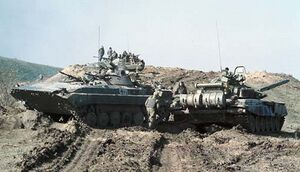War in Cascutia
This article is incomplete because it is pending further input from participants, or it is a work-in-progress by one author. Please comment on this article's talk page to share your input, comments and questions. Note: To contribute to this article, you may need to seek help from the author(s) of this page. |
| War in Cascutia | |||||||
|---|---|---|---|---|---|---|---|
| Part of The Vasilin Sea crisis(1967-2019) | |||||||
 Saterocian troops discuss combat strategies south of Qaqarsville, 1994 | |||||||
| |||||||
| Belligerents | |||||||
|
• Saterocian Army • Saterocian Air Force • Cascutian Regional Guard • Saterocian Special Forces • Loyalist paramilitaries: Qaqar Volunteer Force Satero-Cascute Defense Regiment |
QDA(Until 2020) CLO(Until 2020) Northern Islamic Faction MRF Qaqar Jihad Forces Free Cascutia Army | ||||||
| Commanders and leaders | |||||||
|
Former |
QDA: Olzhas Yedilev(1967-1969) Akhmet Roustav(1969-1981) Aidyn Kenesev(1981-1988) Fauske Alenov(1988-2004) Roberte-Kenes Arnivel(2004-2018) Merenet Al-Mokret(2018-2020) Islamic Faction: Poroe Slavinoch(1994-1996) Nursultan Jeanev(1996-) | ||||||
| Strength | |||||||
|
Qaqar Regional Guard: 3,500 SC Defense Regiment: 13,470 |
Estimated 53,000 in total(2015) Saterocian claim: 27,000 | ||||||
| Casualties and losses | |||||||
|
Qaqar Regional Guard: 284 killed SC Defense Regiment: 102 killed |
~20,660 killed ~70,000 demobilized | ||||||
|
162,000+ killed, including at least 120,000 civilians 300,000-500,000 displaced | |||||||
The War in Cascutia, also known as the Cascutian conflict, is an ongoing low-intensity asymmetrical conflict mainly in northern Sateroc, an area also known as Cascutia, between the Saterocian Armed Forces, ethnic separatists, religious separatists, along with terrorists and extremists. These included the Qaqar Democratic Army(QDA) and the Islamist Northern Islamic Forces(NIF), among others, fighting against each other and the Saterocian government for control of the ethnically-different region of Cascutia. However, these groups have disbanded and demobilized in 2020, leaving a decentralized coalition of dissidents. International governments have condemned all sides of the conflict, due to "concerning actions" by the government of Sateroc, along with the numerous separatist forces. This conflict was also heavily tied to the Vasilin Sea crisis in the 1990s.
The conflict stems from ethnic and religious tensions between the Saterocians and the Cascutians, the latter of which were invaded by Saterocian forces in 1812 following the country's unification just over a century prior. In the midst of dissatisfaction with the Saterocian monarchy during the mid-20th century, especially in Cascutia, a certain Merenet Al-Mokret rose to prominence after founding the Rally for Cascutian Liberation, which was supposed to be a political party in Cascutia to push for eventual independence. However, following the Saterocian Revolution, and the rise of a nationalist militarist regime led by Arnaud Puoc, fighting started in 1967 after a heavy crackdown on Cascutian independence movements. Since then, the conflict has been waged asymmetrically, with guerilla campaigns, war crimes by both sides, terrorist attacks, an alleged genocide, and much more.
According to the Satero-Cascute National Conflict Study Center, at least 162,000 had been killed in the fighting between 1967 and 2020, with most being civilians targetted by either side of the fighting(~50,000 fighters and 112,337 civilians). It is also estimated that around 78% of the total deaths in the conflict were between 1993 and 1998, when the conflict peaked in intensity. It is also estimated that anywhere from 300,000 to 500,000 citizens were internally displaced as a result of fighting, attacks, or kidnappings. Around 18.3% of Saterocians were affected by the conflict in one way or another, and therefore have been labelled as victims. About one out of every three Saterocians affected by the conflict are children, and tens of thousands of civilians have disappeared as a result of kidnappings, either state-sponsored or done by separatist forces. Saterocian forces accounted for 63% of all civilian deaths, with right-wing separatist forces accounting for 21% and left-wing accounting for 16%.
On 17 November 2020, after the 2019 Saterocian revolution, a treaty between the new Saterocian government, most major ethnic separatist organizations, and religious separatist organizations was signed, ending the major phases of the 50-year long conflict. The Saterocian National Assembly unanonimously approved a revised version of the peace plan less than a month later. What followed is an ongoing period of demobilization efforts by Saterocian forces, and, although most separatist forces committed to the peace plan, a number of them are still waging a low-intensity asymmetrical conflict to this day after the Saterocian military launched an offensive against remaining dissidents. In 2023, there was a renewed spike in fighting amidst the 2023 Sateroc conflict
Background
Timeline
Early years(1967-1969)
Intensification of fighting(1969-1978)
Rise of Islamist groups(1978-1992)
Peak in fighting(1992-1999)
Rural fighting(1999-2011)
Conflict under Georg Puoc(2011-2019)
Peace process & after(2011-present)
Main article: Barellosgrad Treaty